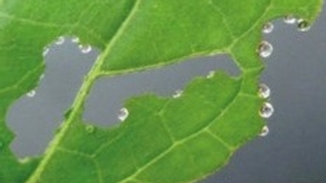
泣蜜求援
This Plant Bleeds Nectar to Attract Help
泣蜜求援
播音/撰文 辛迪亚·盖伯 (Cynthia Graber)
翻译 Meatle
审校 Arc Ma
When a species of nightshade is injured by hungry beetles, it produces sugary nectar at the wound site. The nectar attracts ants that then keep the beetles at bay.
当饥饿的甲虫噬咬一种茄属物种时,这种植物会在伤口中分泌含糖的汁液,以此来吸引蚂蚁,进而驱赶甲虫。
Plants, just like animals, get injured. For plants, it’s often because some herbivore is snacking on them. And, also like animals, plants usually seal those wounds up quickly to avoid infection or the loss of important materials.
植物,就像动物一样,也会受伤。由于草食动物的生存需要,这种状况对于植物而言相当常见。同时,与动物相似,植物的身体也会迅速封住伤口,防止感染和重要物质的流失。
But scientists recently found a plant that does not seal up a wound. Instead, a type of nightshade called Solanum dulcamara does its version of bleeding, releasing drops of an unusual liquid at the wound site.
然而,研究者最近发现了一种植物并不会封上身上的伤口。这种被称谓苦茄 (Solanum dulcamara) 的植物通过流血,在伤口上释放一种不寻常的液体。
“What we found is that the plant is actually damaged by herbivores like most plants are in nature. And in response to that it secretes sugar secretions from the wound edges where the herbivores have damaged the plant.” Tobias Lortzing is a graduate student at Freie Universit?t Berlin and one of the study authors.
“我们发现这种植物就如大多数植物一样会被食草动物伤害。而作为应对,这种植物会在食草动物噬咬所造成的伤口的边沿上分泌出含糖的分泌物。”柏林自由大学 (Freie Universit?t Berlin) 的研究生,同时也是这个研究的研究者之一,托比厄斯·洛特金(Tobias Lortzing)说。
The researchers at first thought the flow could be just a passive bleeding, where the plant lost some of the sugar solution being transported internally.
起初,研究人员认为这种分泌物是一种被动的流血。这些伤口造成了本来要送到植物体内的糖类物质的流失。
[TL:] “But it might also be and that is what we finally could show that the plant is excreting the stuff on purpose. So it's changing the chemical composition and it also controls the amount of secretion that it produces.”
[TL:]“然而这也有可能是植物故意为之,最终我们也确认了这点,因为这种植物能够改变分泌物的组成和分泌量。”
The sugary liquid is a kind of nectar. But it’s not the nectar found in flowers that attracts pollinators. It’s actually the type of nectar that’s sometimes produced to attract insects that protect the plant from herbivores. But that nectar is secreted at a specific structure called a nectary. Instead, this bleeding nectar is produced at a wound site. But it does indeed attract helpers—in this case, ants that then serve as sugar-paid mercenaries in the fight against beetle larvae.
这种含糖的分泌物就如花蜜一般,但这并不是用来吸引传粉者。事实上,这种分泌物是用来吸引昆虫,使到植物本身免受食草动物的侵扰。另一方面,含糖的分泌物一般是由蜜腺产生,而在苦茄身上,这种分泌物源于伤口的位置。但这种分泌物确实唤来救援,在该项研究中,蚂蚁们收下了苦茄支付甜蜜的雇佣费,为苦茄驱赶甲虫幼虫。
[TL:] “And the larvae have to climb up the stems because they mine into the young stems on the plant, which are about half a meter to a meter up the stem. And on their way up to the stems, they are attacked by the ants, which are patrolling the plant.”
Protected plants grow 10 to 13 percent better than the plants without the ant army. The finding is in the journal Nature Plants. [Tobias Lortzing et al, Extrafloral nectar secretion from wounds of Solanum dulcamara]
[TL:]“幼虫需要爬到植物茎的上部,大概离下部半米的位置,然后挖食那里幼嫩的组织。而在幼虫前进的路上,他们会遭受到在那里巡逻的蚂蚁。”有蚂蚁守护的植物比没有的植物的长势好10-13%。这项发现发表在Nature Plants上。
The scientists say this is the first documented instance of nectar that attracts a particular animal assistant being produced outside of a nectary. In fact, the observed nectar bleeding might actually be an early system that evolved to include the nectaries found in other plants today. A process that, though not short, was certainly sweet.
研究人员表示,这是首次发现不使用蜜腺吸引特定的动物保护植物的例子。事实上,这种通过伤口分泌糖蜜的方式可能是一种原始的系统,这种系统演化为现今能在其他植物身上找到的蜜腺。这个过程,尽管并不短暂,但肯定是甜美的。
未经书面许可任何人不得复制或镜像
京ICP备11000850号-1
 京公网安备11010502039775号
京公网安备11010502039775号 信息网络传播视听节目许可证0111611号
国家科技基础条件平台

















